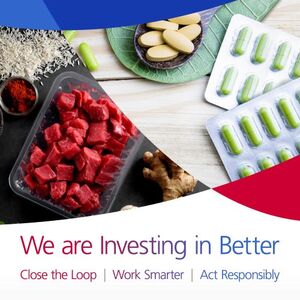Unlocking business value through CSRD and strategic sustainability reporting

Sustainability requires collective action, with everyone playing a role in driving progress. However, is there a risk that upcoming developments in mandatory sustainability reporting may see some prioritising compliance over the transformative change we should aspire to?
The Corporate Sustainability Reporting Directive (CSRD) is reshaping ESG reporting by making double materiality assessments and standardised disclosures mandatory. With the approval on 3 April 2025 of the stop the clock element of the Simplification Omnibus package , a phased rollout delay applies for some companies, but the shift toward strategic, transparent sustainability reporting remains firmly in motion.
While sustainability reporting isn’t new, frameworks like the CSRD are raising the bar. When done effectively - supported by clear ESG goals, double materiality assessments, and long-term sustainability strategy - it can unlock real business value and help drive performance improvements across businesses and their entire value chains.
At kp, we offer our customers an extensive portfolio of high-quality, sustainable plastic packaging and related solutions, and sustainability sits at the heart of everything we do. We publicly committed to ambitious sustainability targets in 2021, when we launched our Investing in Better strategy.
This has focused us on the following actions:
This has focused us on the following actions:
- Close the Loop – championing the circular economy.
- Work Smarter – using as few resources as possible, as efficiently as possible.
- Act Responsibly – keeping our teams safe and strengthening our inclusive culture.
 However, we’re entering a new era that sees sustainability reporting move from a nice-to-have, to a legal necessity under frameworks like the Corporate Sustainability Reporting Directive (CSRD) and the subsequent Omnibus package.
However, we’re entering a new era that sees sustainability reporting move from a nice-to-have, to a legal necessity under frameworks like the Corporate Sustainability Reporting Directive (CSRD) and the subsequent Omnibus package.Issued by the European Commission, the Directive marks a new chapter as it requires companies to disclose what they see as the risks and opportunities arising from social, environmental and governance issues, and to share the impact of their activities on people and the environment.
The changing ESG landscape: what the CSRD means for businesses
When kp set out on its sustainability journey, achieving a 50% reduction in GHG emissions seemed ambitious. Today, our progress is proof that bold goals drive meaningful results.
When done well, sustainability reporting can deliver several key benefits:
The first companies subject to the CSRD were required to implement the new rules in their 2024 financial year, with reports published in 2025. While we've already seen examples of this in practice, on 26 February 2025, the European Commission adopted a package of proposals to delay implementation for certain companies. This postponement limits the scope of the CSRD to the largest companies – those with more than 1,000 employees – prioritising the reporting obligations of organisations most likely to have significant impacts.
When done well, sustainability reporting can deliver several key benefits:
- Competitive advantage
- Improved stakeholder trust
- Access to capital
However, the effectiveness of voluntary reporting can be limited by a lack of standardisation, selective disclosure and inconsistent quality - challenges that mandatory sustainability reporting frameworks like the CSRD aim to address.
The first companies subject to the CSRD were required to implement the new rules in their 2024 financial year, with reports published in 2025. While we've already seen examples of this in practice, on 26 February 2025, the European Commission adopted a package of proposals to delay implementation for certain companies. This postponement limits the scope of the CSRD to the largest companies – those with more than 1,000 employees – prioritising the reporting obligations of organisations most likely to have significant impacts.
How CSRD sets the new standard for ESG disclosure
The CSRD will harmonise and elevate ESG reporting standards because it demands:
- Mandatory transparency – with companies disclosing their social and environmental impacts, risks and opportunities in a way that has never been required before, including through double materiality assessments, which ensure reporting considers both financial impacts on the company and the company’s broader impact on society and the environment.
- Operational insights – because of the requirement to collect and analyse ESG data, which will help uncover inefficiencies and drive innovation.
- Standardisation across industries – allowing comparability across companies and enabling benchmarking against peers.
- Credibility – with investors, customers, and regulators due to the requirement for independent assurance.
Why double materiality is central to CSRD
Turning CSRD compliance into a competitive advantage
As a large, sustainable plastic packaging manufacturer operating across 30 sites worldwide, with our headquarters in Europe, we’ve already put a lot of time and effort into collecting accurate, consistent, and comprehensive datasets. It is exciting to work alongside experts who create innovative films and trays that protect medication and medical devices, keep products safe, help avoid food waste, and preserve the integrity of countless products, and who really care about sustainability and circularity.
And it is empowering for everyone when we see how kp’s transparent and consistent sustainability reporting is already paying off in tangible ways:
 II’m proud of what we’ve achieved, but I also know there is still a long way to go. I say this as we write the next iteration of our sustainability strategy and as I sit here refreshing the roadmap to ensure we’re ready to fulfil our CSRD compliance responsibilities, fully aware of the uncertainty in planning due to evolving EU sustainability regulations.
II’m proud of what we’ve achieved, but I also know there is still a long way to go. I say this as we write the next iteration of our sustainability strategy and as I sit here refreshing the roadmap to ensure we’re ready to fulfil our CSRD compliance responsibilities, fully aware of the uncertainty in planning due to evolving EU sustainability regulations.
As we prepare to report, we will constantly be reminded that collaboration isn’t just beneficial – it’s essential. Partnering with our value chains ensures traceability, transparency, and progress toward shared goals.
I hope organisations view mandatory sustainability reporting as more than a regulatory tickbox. For those who go beyond compliance, integrating sustainability strategy into business planning and using the reporting process as a tool for reflection and innovation, it has the power to be a catalyst for meaningful transformation that can unlock long-term value.
And it is empowering for everyone when we see how kp’s transparent and consistent sustainability reporting is already paying off in tangible ways:
- In 2024 we submitted our climate disclosures to CDP (formerly the Carbon Disclosure Project). We were proud to achieve a ‘B’ rating, underscoring our dedication to reducing environmental impact for the second year in a row.
- In 2023 , our GHG emissions (Scope 1 and 2) were 47% lower than our 2019 baseline, demonstrating substantial progress, and our use of post-consumer recycled material (PCR) across kp stood at around 25%, a great achievement from all our teams – from procurement to operations, to innovation to sales.
 II’m proud of what we’ve achieved, but I also know there is still a long way to go. I say this as we write the next iteration of our sustainability strategy and as I sit here refreshing the roadmap to ensure we’re ready to fulfil our CSRD compliance responsibilities, fully aware of the uncertainty in planning due to evolving EU sustainability regulations.
II’m proud of what we’ve achieved, but I also know there is still a long way to go. I say this as we write the next iteration of our sustainability strategy and as I sit here refreshing the roadmap to ensure we’re ready to fulfil our CSRD compliance responsibilities, fully aware of the uncertainty in planning due to evolving EU sustainability regulations.As we prepare to report, we will constantly be reminded that collaboration isn’t just beneficial – it’s essential. Partnering with our value chains ensures traceability, transparency, and progress toward shared goals.
I hope organisations view mandatory sustainability reporting as more than a regulatory tickbox. For those who go beyond compliance, integrating sustainability strategy into business planning and using the reporting process as a tool for reflection and innovation, it has the power to be a catalyst for meaningful transformation that can unlock long-term value.

From compliance to innovation: the future of sustainability reporting
We know sustainability is a priority for us as a business and for our customers. While we currently report voluntarily to ensure transparency, the future will bring greater scrutiny, and I’m optimistic that one day sustainability reporting will be as important as financial reporting. For now, as we enter an era of alignment and regulation of reporting, I’m excited about what greater harmonisation can offer.
What comes next? I can’t say for sure, but I have no doubt technology and ESG data transparency will play a huge role in how sustainability reporting develops. Over the last decade, the landscape has transformed, and the question for me isn’t whether we can keep up – it’s how far we can lead.
Collective action is vital to address global issues like climate change and natural resource depletion. Reporting requirements aside, we all need to embrace sustainability, think for the long term, and foster collaborative partnerships to drive meaningful change.
Even if your organisation isn’t directly affected by CSRD, how will you drive sustainability reporting beyond a tick-box exercise?
More sustainability stories







